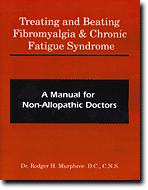|
|
Treating and Beating Fibromyalgia and Chronic Fatigue Syndrome: A Manual for Non-Allopathic Doctors
Book Review by Steven Lavitan, DC, Lac
|
Title:
|
Treating and Beating Fibromyalgia and Chronic Fatigue Syndrome: A Manual for Non-Allopathic Doctors
|
|
Author:
|
Rodger Murphree, DC
|
|
Part #:
|
T-276
|
 Dr. Murphree has remade his practice repeatedly. First, he was a musculoskeletal man, seeing 70 to 80 patients a day solo. Then, still by himself, he worked on 15 to 25 medical misfits per day. He then medically integrated a prescriptive and natural practice, including pharmaceuticals, I.V., chelation, hydrogen peroxide, human growth hormone, etc. When the bureaucracy grew to intolerable dimensions, he sold his interest and opened up his own one-man practice again.
Dr. Murphree has remade his practice repeatedly. First, he was a musculoskeletal man, seeing 70 to 80 patients a day solo. Then, still by himself, he worked on 15 to 25 medical misfits per day. He then medically integrated a prescriptive and natural practice, including pharmaceuticals, I.V., chelation, hydrogen peroxide, human growth hormone, etc. When the bureaucracy grew to intolerable dimensions, he sold his interest and opened up his own one-man practice again.
Dr. Murphree is a well-researched and street-smart author who has distilled much of his professional experience into this manual. He writes from a position of knowledge and experience. He includes sections on physical and spiritual approaches, but most of the book is from the chemical-nutritional viewpoint. He discusses some of the most sophisticated approaches using pharmaceuticals, vitamins, herbs, and amino acids that you are likely to see. The book is a great introduction or a worthwhile addition for the health care professional with an interest in nutritional chemistry.
The book has 26 dense chapters (it took this reviewer over a month to read it) and includes much of the latest research supporting positions for Dr. Murphree's treatment rationales. An appendix follows, which is almost a second book in itself. Included are his intake forms and check lists for history, medication, sleep, neurotransmitters; bowel, immune, liver, and adrenal functions; digestion, diet, pain, and intestinal dysbiosis; symptom questionnaires for yeast problems, thyroid, brain function, and parasites; cholesterol-lowering protocol, high blood pressure protocol, Dr. Coca's pulse test to determine reactive foods, Barnes's basal temperature testing, and adrenal fatigue risk; as well as the ranges and significance of numerous blood, stool, saliva and hair analyses. All of his forms can be photocopied for distribution purposes.
The brain function profile rates a special mention. It is based on a patient questionnaire used to rate their psychological tendencies. Depending on the items checked, one can determine if the patient is in the "O," "G," "D," "N" or "S" group - opioid, GABA, dopamine, norepinephrine, or serotonin deficiency, respectively.
The clinical gems in Treating and Beating Fibromyalgia and Chronic Fatigue Syndrome seem never-ending. For example, there is a challenge test using lactulose and mannitol. After the patient drinks a cocktail containing both, urine is collected for six hours. If the large lactulose molecules are not in the urine sample, intestinal permeability or leaky gut syndrome is suggested. If the small mannitol molecules are in the urine, malabsorption is a distinct possibility. Neither finding is good from a patient's point of view, but both are treatable and retestable to see if the problem has been corrected.
Also discussed is Ragland's test, which for those of you unfamiliar with it, is also called the orthostatic blood pressure test. When the adrenal-healthy person arises from lying to standing position, there is an 8 mm to 10 mm rise in systolic blood pressure because of changes to cerebral blood dynamics. A 0 mm to 5 mm rise indicates a borderline problem, while a drop indicates an adrenal insufficiency. This is an old test that is quick, easy, significant and too rarely performed.
Dr. Murphree is one of the doctors of the future that Edison talked about. Although he is oriented toward nutrition and recommends many foods and herbs, many of his formulations are of the nutriceutical variety. This book is a wonderful addition to his earlier work for patients. It is well-referenced and self-contained at the same time.
Dr. Lavitan's Rating:
 10
out of
10
10
out of
10
|

|








